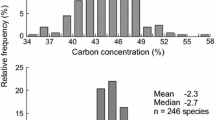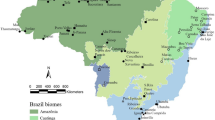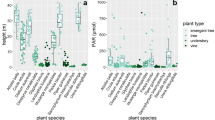Summary
More than 500 species of the Poaceae are found in Kenya, East Africa. Eighteen of twenty-seven tribes are exclusively (except the Paniceae and Danthonieae) of the C3 photosynthetic type. A floristic analysis of low altitude grasslands suggests that nearly all species at these low altitudes are of the C4 photosynthetic type. At high altitudes, however, nearly all grasses are of the C3 photosynthetic type. Open grassland vegetation was sampled along a transect from arid low altitude sites to the top of Mt. Kenya in an attempt to document the general distributions of the photosynthetic types.
The major tribes illustrated three general patterns of distribution. The C4 tribes Chlorideae, Eragrosteae, Sporoboleae, and Aristideae were abundant at low altitudes (or low indices of available soil moisture). The Paniceae and Andropogoneae were also exclusively C4 but were more common at intermediate altitudes. The C3 tribes Aveneae, Festuceae, and Agrostideae were found only at high altitudes. In these open grasslands there were no C3 species below 2,000 m and no C4 species above 3,000 m. The variation in δ13C of the live grass vegetation with altitude confirms these distributional patterns and suggests a sharp transition zone between these two photosynthetic types. The photosynthetic type accounts for broad distributions within the Poaceae but these distributions are further modified by characteristics which may be inherent in the tribal groups. Ecological and paleoecological significance of these patterns of distribution are discussed.
Similar content being viewed by others
References
Björkman, O.: Adaptive and genetic aspects of C4 photosynthesis. In: CO2 metabolism and plant productivity. Proceedings of the Fifth Annual Harry Steenbok Symposium, Madison, Wisconsin, June 9–11, 1975 (R.H. Burris, C.C. Black, eds.), pp. 287–309. Baltimore: University Park Press 1976
Bogdan, A.V.: A revised list of Kenya grasses. Nairobi: The Government Printer 1958
Bremen, H., Cissé, A.M.: Dynamics of Sahelian pastures in relation to drought and grazing. Oecologia (Berl.) 28, 301–315 (1977)
Brown, W.V.: The Kranz syndrome and its subtypes in grass systematics. Memoirs of the Torrey Botanical Club 23, 1–97 (1977)
Brown, W.V., Smith, B.N.: Grass evolution, the Kranz syndrome, 13C/12C ratios, and continental drift. Nature 239, 345–346 (1972)
Burris, R.H., Black, C.C.: CO2 Metabolism and plant productivity. Proceedings of the Fifth Annual Harry Steenbok Symposium, Madison, Wisconsin, June 9–11, 1975 (R.H. Burris, C.C. Black, eds.). Baltimore: University Park Press 1976
Caldwell, M.M., White, R.S., Moore, T.T., Camp, L.B.: Carbon balance, productivity and water use of cold-winter desert shrub communities dominated by C3 and C4 species. Oecologia (Berl.) 29, 275–300 (1977)
Caughley, G.J.: The elephant problem — an alternative hypothesis. E. Afr. Wildl. J. 14, 265–283 (1976)
Clayton, W.D.: Gramineae (Part 1). In: Flora of Tropical East Africa (E. Milne-Redhead, R.M. Polhill, eds.), pp. 1–176. London: Crown Agents for Oversea Governments and Administrations 1970
Clayton, W.D.: Gramineae (Part 2). In: Flora of Tropical East Africa (E. Milne-Redhead, R.M. Polhill, eds.), pp. 177–449. London: Crown Agents for Oversea Governments and Administrations 1974
Coe, M.J., Cumming, D.H., Phillipson, J.: Biomass and production of large African herbivores in relation to rainfall and primary production. Oecologia (Berl.) 22, 341–354 (1976)
Ehleringer, J.R.: Implications of quantum yield differences on the distributions of C3 and C4 grasses. Oecologia (Berl.) 31, 255–267 (1978)
Ehleringer, J.R., Björkman, O.: Quantum yields for CO2 uptake in C3 and C4 plants. Plant Physiol. 59, 86–90 (1977)
Evans, L.T.: Evolutionary, adaptive, and environmental aspects of the photosynthetic pathway: Assessment. In: Photosynthesis and photorespiration (M.D. Hatch, C.B. Osmond, R.O. Slatyer, eds.), pp. 130–136. New York: Wiley 1971
Gaudet, J.J.: Uptake, accumulation, and loss of nutrients by papyrus in tropical swamps. Ecology 58, 415–422 (1977)
Hartley, W.: Studies on the origin, evolution, and distribution of the Gramineae. I. The Tribe Andropogoneae. Austl. J. Bot. 6, 116–128 (1958)
Hartley, W.: Studies on the origin, evolution, and distribution of the Gramineae. II. The Tribe Paniceae. Austl. J. Bot. 6, 343–357 (1958)
Hartley, W.: Studies on the origin, evolution, and distribution of the Gramineae. IV. The Genus Poa. Austl. J. Bot. 9, 152–161 (1961)
Hartley, W.: Studies on the origin, evolution, and distribution of the Gramineae. V. The Subfamily Festucoideae. Austl. J. Bot. 21, 201–234 (1973)
Hartley, W., Slater, C.: Studies on the origin, evolution, and distribution of the Gramineae. III. The Tribes of the Subfamily Eragrostoideae. Austl. J. Bot. 8, 256–276 (1960)
Hatch, M.D.: The C4 pathway of photosynthesis: Mechanism and function. Proceedings of the Fifth Annual Harry Steenbok Symposium, Madison, Wisconsin, June 9–11, 1975 (R.H. Burris, C.C. Black, eds.), pp. 59–81. Baltimore: University Park Press 1976
Hattersley, P.W., Watson, L.: Anatomical parameters for predicting photosynthetic pathways of grass leaves: The ‘maximum lateral cell count’ and the ‘maximum cells distant count’. Phytomorphology 25, 325–333 (1975)
Hofstra, J.J., Aksornkoae, S., Atmowidjojo, S., Banaag, J.F., Santosa, R., Sastrohoetomo, A., Thu, L.T.N.: A study on the occurrence of plants with a low CO2 compensation point in different habitats in the tropics. Annales Bogorienses 5, 143–157 (1972)
Laetsch, M.W.: The C4 syndrome: A structural analysis. Ann. Rev. Plant Physiol. 25, 27–52 (1974)
Lamprey, H.F.: Estimation of the large mammal densities, biomass and energy exchange in the Tarangire Game Reserve and the Masai Steppe in Tanganyika. E. Afr. Wildl. J. 2, 1–46 (1964)
Leuthold, W.: Changes in tree populations of Tsavo East National Park, Kenya. E. Afr. Wildl. J. 15, 61–69 (1977)
Leuthold, W., Leuthold, B.M.: Density and biomass of ungulates in Tsavo East National Park, Kenya. E. Afr. Wildl. J. 14, 49–58 (1976)
Livingstone, D.A.: Late quaternary climatic change in Africa. Ann. Rev. Ecol. Syst. 6, 249–280 (1975)
Myers, N.: Tsavo National Park, Kenya, and its elephants: An interim appraisal. Biol. Cons. 5, 123–132 (1973)
Palmer, P.G.: Grass cuticles: A new paleoecological tool for East African lake sediments. Can. J. Bot. 54, 1725–1734 (1976)
Pratt, D.J., Greenway, P.J., Gwynne, M.D.: A classification of East African rangeland. J. Appl. Ecol. 3, 369–382 (1966)
Smith, B.N.: Evaluation of C4 photosynthesis, pp. 5–21. In: The fractionation of stable carbon isotopes by plants (C.R. Benedict, ed.). Symposium of the Southern Section of ASPP. College Station, Texas: Texas A & M University Press 1976
Smith, B.N., Brown, W.V.: The Kranz syndrome in the Gramineae as indicated by carbon isotopic ratios. Am. J. Bot. 60, 505–513 (1973)
Smith, B.N., Robbins, M.J.: Evolution of C4 photosynthesis: An assessment based on 13C/12C ratios and Kranz anatomy. In: Proceedings of the Third International Congress on Photosynthesis, Sept. 2–6, 1974 (M. Avron, ed.), pp. 1579–1587. The Weizman Institute of Science, Rohovot, Israel. Amsterdam. The Netherlands: Elsevier 1974
Stowe, L.G., Teeri, J.A.: The geographic distribution of C4 species of the dicotyledonae in relation to climate. Nat. 112, 1–26 (1978)
Teeri, J.A., Stowe, L.G.: Climatic patterns and distributions of C4 grasses in North America. Oecologia (Berl.) 23, 1–12 (1976)
Tieszen, L.L.: Photosynthetic properties of some grasses in eastern South Dakota. Proc. S.D. Acad. Sci. 49, 78–89 (1970)
Tieszen, L.L., Hein, D., Qvortrup, S.A., Troughton, J.H., Imbamba, S.K.: Use of δ13C values to determine vegetation selectivity in East African ungulates. Oecologia (Berl.) 37, 351–359 (1979)
Ting, I.P.: Nonautotrophic CO2 fixation and crassulacean-acid-metabolism, pp. 169–185. In: Photosynthesis and photorespiration (M.D. Hatch, C.B. Osmond, R.O. Slatyer, eds.). New York: Wiley 1971
Troughton, J.H.: Aspects of the evolution of the photosynthetic carboxylation reaction in plants, pp. 124–129. In: Photosynthesis and photorespiration (M.D. Hatch, C.B. Osmond, R.O. Slatyer, eds.). New York: Wiley 1971
Troughton, J.H., Card, K.A.: Temperature effects on the carbon-isotope ratio of C3, C4 and crassulacean-acid-metabolism (CAM) plants. Planta (Berl.) 123, 185–190 (1975)
Vesey-Fitzgerald, D.F.: Animal impact on vegetation and plant succession in Lake Manyara National Park, Tanzania. Oikos 24, 314–324 (1973)
Vesey-Fitzgerald, D.F.: The changing state of Acacia xanthophloea groves in Arusha National Park, Tanzania. Biol. Cons. 6, 40–47 (1974)
Western, D., van Praet, C.: Cyclical changes in the habitat and climate of an East African ecosystem. Nature 241, 104–106 (1973)
Williams, G., III.: Photosynthetic adaptation to temperature in C3 and C4 grasses. A possible ecological role in the shortgrass prairie. Pl. Physiol. 54, 709–711 (1974)
Williams, G.J., Kemp, P.R., Oulton, K.: Anatomical, physiological, and biochemical evidence for the C3 pathway in Verbascum thapsus L. New Phytol. 79, 489–492 (1977)
Williams, G.J., Markley, J.L.: The photosynthetic pathway of North American shortgrass prairie species and some ecological implications. Photosynthetica 7, 262–270 (1973)
Winter, K., Troughton, J.H., Card, K.A.: 350-1 values of grass species collected in the Northern Sahara Desert. Oecologia (Berl.) 25, 115–123 (1976)
Woodhead, T.: Classification of East African Rangeland. II. The water balance as a guide to site potential. J. Appl. Ecol. 7, 647–652 (1970)
Author information
Authors and Affiliations
Rights and permissions
About this article
Cite this article
Tieszen, L.L., Senyimba, M.M., Imbamba, S.K. et al. The distribution of C3 and C4 grasses and carbon isotope discrimination along an altitudinal and moisture gradient in Kenya. Oecologia 37, 337–350 (1979). https://doi.org/10.1007/BF00347910
Received:
Issue Date:
DOI: https://doi.org/10.1007/BF00347910




